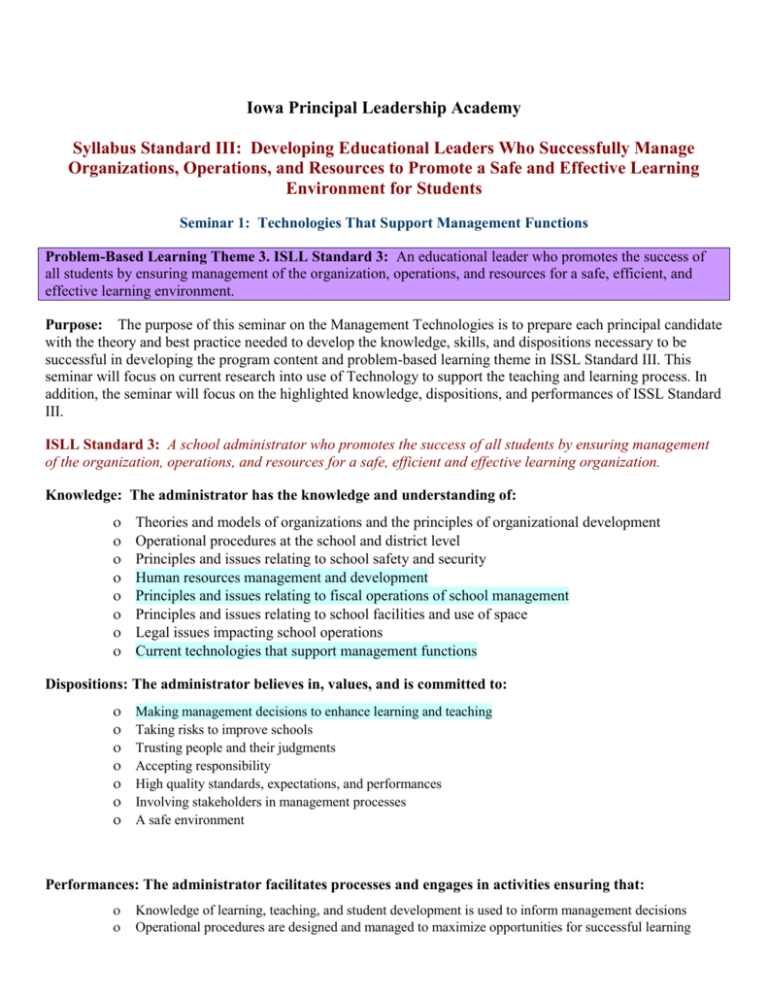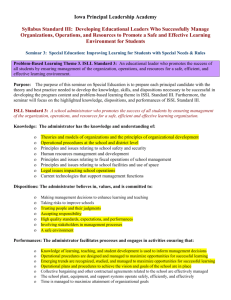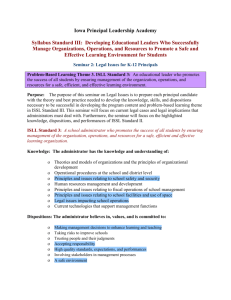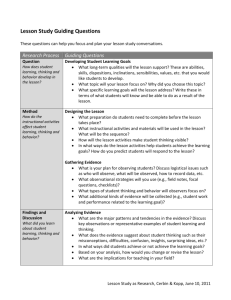Seminar 1 Syllabus
advertisement

Iowa Principal Leadership Academy Syllabus Standard III: Developing Educational Leaders Who Successfully Manage Organizations, Operations, and Resources to Promote a Safe and Effective Learning Environment for Students Seminar 1: Technologies That Support Management Functions Problem-Based Learning Theme 3. ISLL Standard 3: An educational leader who promotes the success of all students by ensuring management of the organization, operations, and resources for a safe, efficient, and effective learning environment. Purpose: The purpose of this seminar on the Management Technologies is to prepare each principal candidate with the theory and best practice needed to develop the knowledge, skills, and dispositions necessary to be successful in developing the program content and problem-based learning theme in ISSL Standard III. This seminar will focus on current research into use of Technology to support the teaching and learning process. In addition, the seminar will focus on the highlighted knowledge, dispositions, and performances of ISSL Standard III. ISLL Standard 3: A school administrator who promotes the success of all students by ensuring management of the organization, operations, and resources for a safe, efficient and effective learning organization. Knowledge: The administrator has the knowledge and understanding of: Theories and models of organizations and the principles of organizational development Operational procedures at the school and district level Principles and issues relating to school safety and security Human resources management and development Principles and issues relating to fiscal operations of school management Principles and issues relating to school facilities and use of space Legal issues impacting school operations Current technologies that support management functions Dispositions: The administrator believes in, values, and is committed to: Making management decisions to enhance learning and teaching Taking risks to improve schools Trusting people and their judgments Accepting responsibility High quality standards, expectations, and performances Involving stakeholders in management processes A safe environment Performances: The administrator facilitates processes and engages in activities ensuring that: Knowledge of learning, teaching, and student development is used to inform management decisions Operational procedures are designed and managed to maximize opportunities for successful learning Emerging trends are recognized, studied, and managed to maximize opportunities for successful learning Operational plans and procedures to achieve the vision and goals of the school are in place Collective bargaining and other contractual agreements related to the school are effectively managed The school plant, equipment, and support systems operate safely, efficiently, and effectively Time is managed to maximize attainment of organizational goals Potential problems and opportunities are identified Problems are confronted and resolved in a timely manner Financial, human, and material resources are aligned to the goals of schools The school acts entrepreneurial to support continuous improvement Organizational systems are regularly monitored and modified as needed Stakeholders are involved in decisions affecting schools Responsibility is shared to maximize ownership and accountability Effective problem-framing and problem-solving skills are used Effective conflict resolution skills are used Effective group-process and consensus building skills are used Effective communications skills are used There is effective use of technology to manage school operations efficiently, and effectively A safe, clean, and aesthetically pleasing school environment is created and maintained Human resource functions support the attainment of school goals Confidentiality and privacy of school records are maintained This seminar will also include theory that supports the understandings of Distributive Leadership Principles 1,4 & 5 and Design Principle 4. Distributive Leadership Principle 1: The purpose of leadership is the improvement of instructional practice and performance, regardless of role. Distributed Leadership Principle 4: The roles and activities of leadership flow from the expertise required for learning and improvement, not from the formal dictates of the institution. Distributed Leadership Principle 5: The exercise of authority requires reciprocity of accountability and capacity. Design Principle 4: Exercise differential treatment based on performance and capacity, not on volunteerism. Endorsement 189 Content and Competencies: Content Standard 4: Knowledge of family support systems, factors which place families at risk, child care issues, and home-school community relationships and interactions designed to promote parent education, family involvement, and interagency collaboration. Content Standard 5: Knowledge of school law and legislative and public policy issues affecting children and families. Content Standard 7: Knowledge of current issues in special education administration Competency 3: Ensures management of the organization, operations, and resources for a safe, efficient, and effective learning environment. Tool Box Activities This Seminar Will Address: Overview of Tool Box Activities: Examine school operations and maintenance plan and decision-making process for meeting staff and student needs and requests. Journal findings. Review with building principal how human and material resources are utilized and decisions made for who does what and who gets what. Journal findings with suggestions for improvement. Review technologies that support management functions. Write a recommendation to your principal/district of your findings. ________________________________________________________________________ BEFORE WEEKEND Review the course syllabus Examine the technologies currently being used in your building that support management functions: i.e. risk management (student discipline, special education, personnel problems), evaluation (staff performance, instructional programs), communication (media, community, parents, staff), classroom management, instructional planning and support, instructional programming, scheduling, diversity, reporting (CSIP, APRs, DE), routine student records (anecdotal, absentees, tardies, discipline). List at least ten things that you learned as a result of your examination. ________________________________________________________________________ Resources and Materials: Course Syllabus AASA Study (1999). Preparing Schools and School Systems for the 21st Century. “Characteristics of 21st Century Technology-Ready Schools.” American Association of School Administrators. Bernhardt, Victoria L., (1994) The School Portfolio. Larchmont: NY: Eye on Education. Berryman, S.E. (1993). Learning for the Workplace. Review of Research in Education, 10, 343-401. Corcoron. T.C. (1995). Transforming Professional Development for Teachers. A Guide for State Policymakers. Washington, DC: National Governor’s Association. DiSessa. A.A. (2000). Changing Minds: Computers, Learning, and Literacy. Cambridge, MA: MIT Press. Educational Research Service, National Association of Elementary School Principals, and National Association of Secondary School Principals (2000). The Principal, Keystone of a High-Achieving School: Attracting and Keeping the Leaders We Need. Education Research Service. Hanushek, E.A. (1989) The Impact of Differential Expenditures on School Performance. Educational Researcher, 18(4): 45-51. Means, B. & Blando, J., Olson, K. & Middleton, T. (1993). Using Technology to Support Education Reform. Washington, DC: Office of Educational Research and Improvement. Moursund, D. (1999). Project-based Learning Using Information Technology. Eugene:OR: ISTE. National Educational Technology Standards for Students, (2000), ISTE. Eugene: Oregon, ISTE. National Schools Boards Association. (1999). Models of Success: Case Studies of Technology in Schools. ISBN)-88364-226-3. North Central Regional Educational Laboratory. (1999) Technology Connections for School Improvement. Chicago: IL. Peterson, Kenneth D., Walhquist, Christine., Bone, Kathie et. al. (2001) “Using More Data Sources to Evaluate Teachers.” Educational Leadership. Vol.58: 5. Rosenholtz, S.J. (1986). “Effective Schools: Interpreting the Evidence.” American Journal of Education 93(3): 352-388. Senge, P.M. (1990). The Fifth Discipline: The Art and Practice of the Learning Organization. New York: Doubleday Currency. Sharp, W. L. Walter, J.K. and Sharp, H.M. (1998). Case Studies for School Leaders. Lancaster: Techomic Publishing Company. Software & Information Industry Association. (1999). Report of the Effectiveness of Technology in Schools. (Study Item No. CLD9988). Washington, DC. U.S. Department of Education. (2000). Monitoring School Quality. Washington, DC NCES 2001-030. This is a problem-centered course: A problem is a troubled perplexed, trying situation…not an assigned task…It is indispensable to distinguish between genuine and mock problems. Does a question naturally suggest itself with some situation? Or is it an aloof thing, only for the purposes of conveying information? Would it arouse observation and engage experimentation outside of school? Or is it the teacher’s or textbook’s, made a problem for the pupil only because he cannot get the required mark unless he deals with it? (John Dewey, Democracy and Education, 1916) Management Technology Overall Goal: The principal goal of management technology is to provide the principal candidate with the theory, research, and best practice needed to support the development of the knowledge, performances, and dispositions of ISSL Standard III and to support the development of each Problem-based Theme. Specific Seminar Goals: To compare research and best practice in using management technologies to improve the teaching and learning to traditional approaches To examine divergent management systems currently being used in Iowa To examine ways that technology supports data gathering and analyzing of student progress and achievement To demonstrate various functions of management technology used to support the school including: risk management, evaluation, communication, classroom management, instructional planning and support, instructional programming, scheduling, diversity, CSIPs, APRs, DE, student records. To examine exemplary uses of management technology in school districts in US To examine the criteria and framework for building a “School Portfolio” Specific Seminar Continuing Objectives: To continue to dialogue with and receive management technology support from the instructor as an expert mentor throughout Problem-based Learning Theme III in completing the action research, action plan, tool box activities, and reflective journaling. To develop specific course tool box journaling and action requirements through consultation with other Cohort Group members and the instructor as an expert mentor. Continue to critique the reference materials and sites and to share knowledge and understandings with cohort group, instructor, and other mentors. Student Assignments and Expectations: Listed in Syllabus 3: Problem-Based Learning Theme 3. Evaluation: Continuous Improve Continuum: Evaluation of the Organization Level 5 on the rubric is assigned for work of the highest academic quality. Level 4 on the rubric is assigned for professional quality work at the required quality level. Level 3 on the rubric is assigned for adequate work, but not distinguished as sound quality at the proficient level. Those with a Level 3 Rubric will have the opportunity to revise and complete quality work. All work for the Iowa Principal Leadership Academy must be completed at Rubric Levels 4 or 5 to be considered proficient. All work must be completed at the proficient level.







